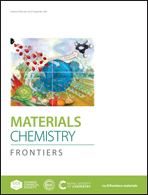Highly dispersed silver nanoparticles confined in a nitrogen-containing covalent organic framework for 4-nitrophenol reduction†
Abstract
One of the key challenges in preparing metal nanoparticle (NP)-based heterogeneous catalysts is to design host substrates with abundant high affinity anchoring sites to address the problem that metal NPs, due to their high surface energy, are easily deactivated by migration-aggregation during the catalytic process. Herein, we demonstrate that two-dimensional nitrogen-containing covalent organic frameworks can be used as host substrates with strong anchoring points to create stable and highly dispersed metal NP catalysts. Highly dispersed ultrafine Ag NPs (2.93 nm) with narrow size distribution have been successfully prepared by utilizing the abundant nitrogen-containing functional groups in the ordered channels of NCOF crystals. The prepared AgNPs@NCOF exhibits superior catalytic activity toward the reduction of 4-NPh. In addition, the AgNPs@NCOF is highly stable and easily reused with no significant loss of catalytic activity. The unique structure of the NCOF provides favorable nucleation sites for Ag NPs, confines the space for size-controlled growth of Ag NPs, and binds Ag NPs tightly through the interface interaction. Our work provides a promising strategy for immobilizing ultrafine metal NPs on porous supports. We hope that metal-based heterogeneous catalysts prepared by further diversification of different COFs and different metal NPs can be used in industrially important transformation reactions.



 Please wait while we load your content...
Please wait while we load your content...